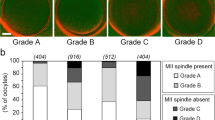Abstract
Purpose : The effect of detectability/location of meiotic spindle to fertilization of human MII oocytes and outcome of clinical IVF/ICSI–ET cycles was studied.
Methods : The location of spindle relative to polar body positioned to 6 o'clock was detected with polscope prior to ICSI in oocytes. Data of 83 IVF/ICSI–ET cycle, including pregnancy results, and a total of 1033 oocytes examined were analyzed retrospectively.
Results : Polar body position does not always accurately predict spindle position. Similar fertilization was observed in the polscope detected and in the control group. The main number of oocytes and spindle positive oocytes collected was higher in the pregnant than in the nonpregnant group. Higher fertilization was found in that group where 2/3-d of the oocytes had detected spindle. The main number of oocytes and spindle positive oocytes obtained decreased with increasing age of patients.
Conclusions : The presence of birefringent spindle predicts higher fertilization and development and greater probability of pregnancy.
Similar content being viewed by others
REFERENCES
Inoue S: Polarization optical studies of the mitotic spindle: I. The demonstration of spindle fibers in living cells. Chromosoma 1953;5:487-500
Waterman-Storer CM: Microtubules and microscopes: How the development of light microscopic imaging technologies has contributed to discoveries about microtubule dynamics in liv-ing cells. Mol Biol Cell 1998;9:3263-3271
Sato H, Ellis GW, Inoue S: Microtubular origin of mitotic spin-dle for birefringence. J Cell Biol 1975;67:501-517
Edwards RG, Brody SA: Principles and Practice of Assisted Human Reproduction. Philadelphia, WB Saunders, 1995
Moore RM. Crosby IM. Temperature-induced abnormalities in sheep oocytes during maturation. J Reprod Fertil 1985;75:476-483
Aman RR, Parks JE: Effects of cooling and re-warming on the meiotic spindle and chromosomes of in vitro-matured bovine oocytes. Biol Reprod 1994;50:103-110
Pickering SJ, Johnson MH: The influence of cooling on the organization of the meiotic spindle of the mouse oocytes. Hum Reprod 1987;2:207-216
Silva CP, Kommineni K, Oldenbourg R, Keefe DL: The first polar body does not predict accurately the location of the metaphase 2 meiotic spindle in mammalian oocytes. Fertil Steril 1999;71:719-721
Liu L, Oldenbourg R, Trimarchi JR, Keefe DL: A reliable, noninvasive technique for spindle imaging and enucleation of mammalian oocytes. Nat Biotech 2000;18:223-225
Liu L, Trimarchi JR, Oldenburg R, Keefe DL: Increased bire-fringence in the meiotic spindle provides a new marker for the onset of activation in living oocytes. Biol Reprod 2000;63:251-258
Wang WH, Meng L, Hackett RJ, Keefe DL: Developmental ability of human oocytes with or without birefringent spin-dles imaged by Polscope before insemination. Hum Reprod 2001;36:1464-1468
Moon JH, Hyun CS, Lee SW, Son WY, Yoon SH, Lim JH: Visualization of the metaphase II meiotic spindle in living hu-man oocytes using the Polscope enables the prediction of em-bryonic developmental competence after ICSI. Hum Reprod 2003;18:817-820
Rienzi I, Ubaldi F, Martinez F, Iacobelli M, Minasi MG, Ferrero S, Tesarik J, Greco E: Relationship between meiotic spindle location with regard to the polar body position and oocyte de-velopmental potential after ICSI. Hum Reprod 2003;18:1289-1293
Tan SL, Brinsden PR: Alternative assisted conception tech-niques. In A Text Book of In Vitro Fertilization and As-sisted Reproduction. PR Brinsden, PA Rainsbury (ed), The Parthenon, 1992;215-227
StatSoft, Inc (2004). STATISTICA(data analysis software sys-tem), version 6. www.statsoft.com
Wang WH, Meng L, Hackett RJ, Oldenbourg R, Keefe DL: Limited recovery of meiotic spindles in living human oocytes after cooling-rewarming observed using polarized light mi-croscopy. Hum Reprod 2001;16:2374-2378
Wang WH, Keefe DL:Prediction of chromosome misalignment among in vitro matured human oocytes by spindle imaging with the PolScope. Fertil Steril 2002;78:1077-1081
Sathananthan AH, Kirby C, Trounson A, Philipatos D, Shaw J: The effects of cooling mouse oocytes. J Assist Reprod Genet 1992;9:139-148
Wang WH, Meng L, Hackett RJ, Oldenbourg R, Keefe DL: Rigorous thermal control during intracytoplasmic sperm in-jection stabilizes fertilization and pregnancy rates. Fertil Steril 2002;77:1274-1277
Pickering SJ, Braude PR, Johnson MH, Cant A, Curie J: Tran-sient cooling to room temperature can cause irreversible dis-ruption the meiotic spindle in the human oocytes. Fert Steril 1990;54:102-108
Battaglia DG, Goodwin P, Klein A: Influence of maternal age on meiotic spindle in oocytes from naturally cycling woman. Hum Reprod 1996;11:2217-2222
Avery S, Blayney M:Effect of the position of the meiotic spindle on the outcome of intracytoplasmic sperm injection (Review). Hum Fertil (Camb) 2003;6:19-22
Author information
Authors and Affiliations
Rights and permissions
About this article
Cite this article
Konc, J., Kanyó, K. & Cseh, S. Visualization and Examination of the Meiotic Spindle in Human Oocytes with Polscope. J Assist Reprod Genet 21, 349–353 (2004). https://doi.org/10.1023/B:JARG.0000046202.00570.1d
Issue Date:
DOI: https://doi.org/10.1023/B:JARG.0000046202.00570.1d




